Phone accessibility features
 Feedback?
Feedback?Cisco desk and conference phones provide accessibility features for the blind, and the visually, hearing, and mobility impaired. Because many of these features are standard, they can be used by users with disabilities without requiring any special configuration.
In this article, the term phone support pages refers to the web pages that users can access to set up certain features.
Cisco is committed to designing and delivering accessible products and technologies to meet the needs of your organization. You can find more information about Cisco and its commitment to accessibility at this URL: http://www.cisco.com/go/accessibility.
Your phone comes with standard accessibility features that require little or no setup.
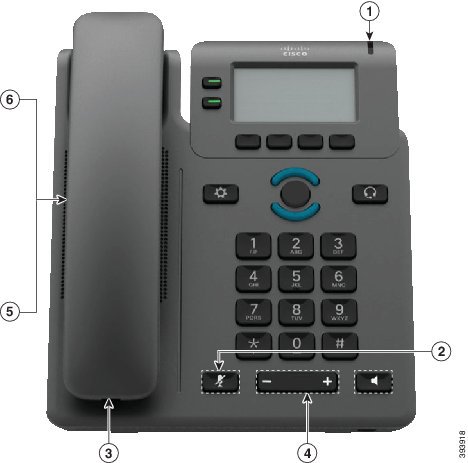
|
Item |
Accessibility Feature |
Description |
|---|---|---|
|
1 |
Visual message-waiting indicator |
This lighted strip is visible from all angles. Your phone also provides an audible message-waiting indicator. |
|
2 |
Visual notification of the phone state |
Use the Mute button to toggle the microphone on or off. When the microphone is muted, the mute icon flashes on the screen |
|
3 |
Inline-amplifier support (handset) |
Cisco IP Phone handsets support third-party inline amplifiers. You attach an amplifier to the handset and cord and it sits between the handset and the IP phone. |
|
4 |
Adjustable ringtone, pitch, and volume |
Your administrator can also change your settings. |
|
5 |
Hearing aid compatible (HAC) handset |
Supports these accessibility features:
|
|
6 |
Acoustic coupled TTY and TDD support (handset) |
Cisco IP Phones support these TTY and TDD features:
For information about setting up TTY, contact your administrator. |
Your phone comes with standard accessibility features that require little or no setup.
To check which phone model you have, press Applications ![]() and select . The Product name field shows your phone model.
and select . The Product name field shows your phone model.
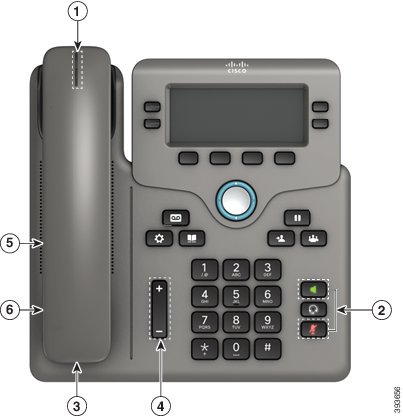
|
Item |
Accessibility Feature |
Description |
|---|---|---|
|
1 |
Visual message-waiting indicator (handset) |
This lighted strip is visible from all angles. Your phone also provides an audible message-waiting indicator. |
|
2 |
Visual notification of the phone state |
|
|
3 |
Inline-amplifier support (handset) |
Cisco IP Phone handsets support third-party inline amplifiers. You attach an amplifier to the handset and cord and it sits between the handset and the IP phone. |
|
4 |
Adjustable ringtone, pitch, and volume |
Your administrator can also change your settings. |
|
5 |
Hearing aid compatible (HAC) handset |
Supports these accessibility features:
|
|
6 |
Acoustic coupled TTY and TDD support (handset) |
Cisco IP Phones support these TTY and TDD features:
For information about setting up TTY, contact your administrator. |
Your phone comes with standard accessibility features that require little or no setup.
To check which phone model you have, press Applications ![]() and select . The Product name field shows your phone
model.
and select . The Product name field shows your phone
model.
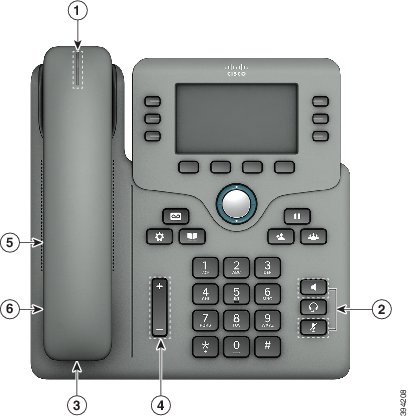
|
Item |
Accessibility Feature |
Description |
|---|---|---|
|
1 |
Visual message-waiting indicator (handset) |
This lighted strip is visible from all angles. Your phone also provides an audible message-waiting indicator. |
|
2 |
Visual notification of the phone state |
|
|
3 |
Inline-amplifier support (handset) |
Cisco IP Phone handsets support third-party inline amplifiers. You attach an amplifier to the handset and cord and it sits between the handset and the IP phone. |
|
4 |
Adjustable ringtone, pitch, and volume |
Your administrator can also change your settings. |
|
5 |
Hearing aid compatible (HAC) handset |
Supports these accessibility features:
|
|
6 |
Acoustic coupled TTY and TDD support (handset) |
Cisco IP Phones support these TTY and TDD features:
For information about setting up TTY, contact your administrator. |
Your phone comes with standard accessibility features that require little or no setup.

|
Item |
Accessibility Feature |
Description |
|---|---|---|
|
1 |
High-contrast visual and audible alert of an incoming call |
Alerts you to an incoming call. The light strip flashes during incoming calls and stays lit when a voicemail message is received. |
|
2 |
Line and feature buttons The line and feature buttons are on the left of the screen. |
Use line buttons to start, answer, or switch to a call on a particular line. Features, such as speed dial, line status, privacy, do not disturb (DND), and service URLs, can be assigned to feature buttons. Your administrator sets up programmable feature buttons on your phone. Colors indicate your phone's status:
|
|
3 |
Back-lit grayscale LCD screen with adjustable contrast |
Allows you to adjust your phone screen's contrast. |
|
4 |
Softkeys These are large buttons just below the LCD. |
Provide access to special functions. The functions are displayed on the LCD. |
|
5 |
Navigation Cluster (includes the Navigation buttons and the Select button) The Navigation cluster is located in the center of the phone below the softkeys. |
Use the Navigation up and down buttons to move up and down in the phone LCD. The Select button is in the center of the Navigation cluster. |
|
6 |
Applications and Headset button
|
Use the Applications to access functions on your phone. Use the Headset button to toggle the headset on or off. |
|
7 |
Standard 12-key layout |
Allows you to use existing or familiar key positions. Key 5 has a nib. |
|
8 |
|
Provide audible notification of the phone state:
|
|
9 |
Volume key This key is located below the keypad. |
Allows you to increase or decrease the ring volume or the sound through the handset, headset, or speakerphone. Press right on the rocker key to increase the volume. Press left on the rocker key to decrease the volume. |
Your phone comes with standard accessibility features that require little or no setup.
To check which phone model you have, press Applications ![]() and select . The Product name field shows your phone model.
and select . The Product name field shows your phone model.
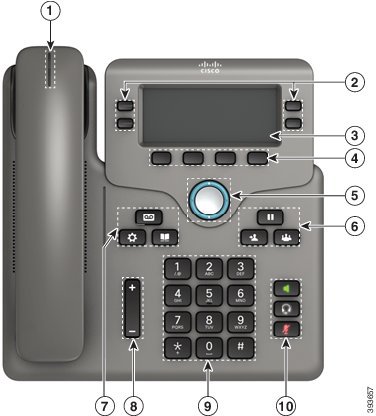
|
Item |
Accessibility Feature |
Description |
|---|---|---|
|
1 |
High-contrast visual and audible alert of an incoming call |
Alerts you to an incoming call. The handset light strip flashes during incoming calls and stays lit when a voicemail message is received. |
|
2 |
Line and feature buttons The line and feature buttons are on the left and right sides of the screen. |
Use line buttons to start, answer, or switch to a call on a particular line. Features, such as speed dial, line status, privacy, do not disturb (DND), and service URLs, can be assigned to feature buttons. Your administrator sets up programmable feature buttons on your phone. Colors indicate your phone's status:
|
|
3 |
Back-lit grayscale LCD screen with adjustable contrast |
Allows you to adjust your phone screen's contrast. |
|
4 |
Softkeys
|
Provide access to special functions. The functions are displayed on the LCD. |
|
5 |
Navigation Cluster (includes the Navigation ring and the Select button) The Navigation cluster is located in the center of the phone. |
Use the Navigation ring to move up and down in the phone LCD. The Select button is in the center of the Navigation cluster. |
|
6 |
Hold button, Transfer button, and Conference button
|
Allow you to use these functions on your phone. |
|
7 |
Messages button, Applications button, and Contacts button
|
Allow you to easily access your messages, applications, and contacts. |
|
8 |
Volume key This key is located to the left of the keypad. |
Allows you to increase or decrease the ring volume or the sound through the handset, headset, or speakerphone. Press up on the rocker key to increase the volume. Press down on the rocker key to decrease the volume. |
|
9 |
Standard 12-key layout |
Allows you to use existing or familiar key positions. Key 5 has a nib. |
|
10 |
|
Provide audible notification of the phone state:
|
Your phone comes with standard accessibility features that require little or no setup.
To check which phone model you have, press Applications ![]() and select . The Product name field shows your phone
model.
and select . The Product name field shows your phone
model.
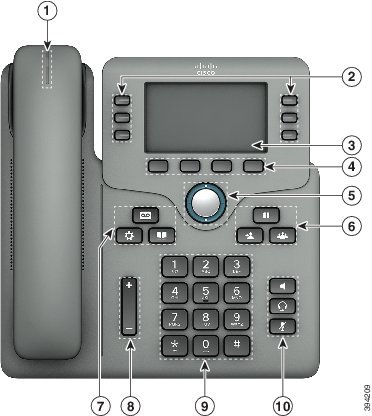
|
Item |
Accessibility Feature |
Description |
|---|---|---|
|
1 |
High-contrast visual and audible alert of an incoming call |
Alerts you to an incoming call. The handset light strip flashes during incoming calls and stays lit when a voicemail message is received. |
|
2 |
Line and feature buttons The line and feature buttons are on the left and right sides of the screen. |
Use line buttons to start, answer, or switch to a call on a particular line. Features, such as speed dial, line status, privacy, do not disturb (DND), and service URLs, can be assigned to feature buttons. Your administrator sets up programmable feature buttons on your phone. Colors indicate your phone's status:
|
|
3 |
Back-lit color LCD screen with adjustable brightness |
Allows you to adjust your phone screen's brightness. |
|
4 |
Softkeys
|
Provide access to special functions. The functions are displayed on the LCD. |
|
5 |
Navigation Cluster (includes the Navigation ring and the Select button) The Navigation cluster is located in the center of the phone. |
Use the Navigation ring to move up and down in the phone LCD. The Select button is in the center of the Navigation cluster. |
|
6 |
Hold button, Transfer button, and Conference button
|
Allow you to use these functions on your phone. |
|
7 |
Messages button, Applications button, and Contacts button
|
Allow you to easily access your messages, applications, and contacts. |
|
8 |
Volume key This key is located to the left of the keypad. |
Allows you to increase or decrease the ring volume or the sound through the handset, headset, or speakerphone. Press up on the rocker key to increase the volume. Press down on the rocker key to decrease the volume. |
|
9 |
Standard 12-key layout |
Allows you to use existing or familiar key positions. Key 5 has a nib. |
|
10 |
Headset, Speakerphone, and Mute button
|
Provide audible notification of the phone state:
|
Your phone comes with standard accessibility features that require little or no setup.

|
Item |
Accessibility Feature |
Description |
|---|---|---|
|
1 |
Lighted buttons |
Allow you to access the following features:
Indicate your phone's status:
|
|
2 |
Large button to access Applications |
Allow you to easily access your phone applications. Additional features are available with the softkeys. |
|
3 |
Built-in speakerphone |
Press the button to turn speakerphone on or off. |
|
4 |
Tactile-discernible buttons and functions, including a nib on Key 5 |
Allow you to easily locate your phone's keys. For example, Key 5 has a nib, which you can use to locate other key positions. |
Your phone comes with standard accessibility features that require little or no setup.
To check which phone model you have, press Applications ![]() and select . The Product name field shows your phone model.
and select . The Product name field shows your phone model.

|
Item |
Accessibility Feature |
Description |
|---|---|---|
|
1 |
Lighted buttons |
Allow you to access the following features:
Indicate your phone's status:
|
|
2 |
Large buttons to access Applications, Messages, Contacts, Hold, Transfer, and Conference |
Allow you to easily access your phone applications, voice messages, corporate and personal directories, and calling features. |
|
3 |
Built-in speakerphone |
Indicates whether the speakerphone is on or off. When the speakerphone is on, the button is lit. |
|
4 |
Tactile-discernible buttons and functions, including a nib on Key 5 |
Allow you to easily locate your phone's keys. For example, Key 5 has a nib, which you can use to locate other key positions. |
Your phone comes with standard accessibility features that require little or no setup.
To check which phone model you have, press Applications ![]() and select . The Product name field shows your phone
model.
and select . The Product name field shows your phone
model.
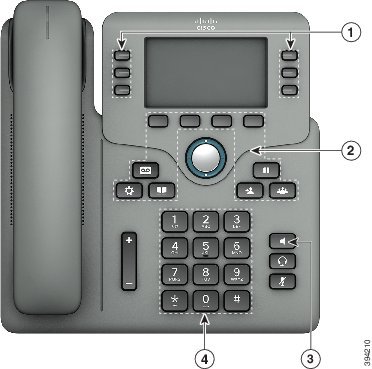
|
Item |
Accessibility Feature |
Description |
|---|---|---|
|
1 |
Lighted buttons |
Allow you to access the following features:
Indicate your phone's status:
|
|
2 |
Large buttons to access Applications, Messages, Contacts, Hold, Transfer, and Conference |
Allow you to easily access your phone applications, voice messages, corporate and personal directories, and calling features. |
|
3 |
Built-in speakerphone |
Indicates whether the speakerphone is on or off. When the speakerphone is on, the button is lit. |
|
4 |
Tactile-discernible buttons and functions, including a nib on Key 5 |
Allow you to easily locate your phone's keys. For example, Key 5 has a nib, which you can use to locate other key positions. |
Your phone comes with standard accessibility features that require little or no setup.
To check which phone model you have, press Applications ![]() and select . The Product name field shows your phone
model.
and select . The Product name field shows your phone
model.

|
Item |
Accessibility Feature |
Description |
|---|---|---|
|
1 |
Visual message-waiting indicator (handset) |
This lighted strip is visible from all angles. Your phone also provides an audible message-waiting indicator. To change the light or the audible voice-message indicator, sign in to the phone support pages and access the message-indicator settings. You can change each setting to on or off. Your administrator can also change your settings. |
|
2 |
Visual notification of the phone state |
|
|
3 |
Inline-amplifier support (handset) |
Cisco IP Phone handsets support third-party inline amplifiers. You attach an amplifier to the handset and cord and it sits between the handset and the IP phone. |
|
4 |
Adjustable ringtone, pitch, and volume |
Your administrator can also change your settings. |
|
5 |
Hearing aid compatible (HAC) handset |
Supports these accessibility features:
|
|
6 |
Acoustic coupled TTY and TDD support (handset) |
Cisco IP Phones support these TTY and TDD features:
For information about setting up TTY, contact your administrator. |
Your Multiplatform phone comes with standard accessibility features that require little or no setup.

|
Item |
Accessibility Feature |
Description |
|---|---|---|
|
1 |
High-contrast visual and audible alert of an incoming call |
Alerts you to an incoming call. The handset light strip flashes during incoming calls and stays lit when a voicemail message is received. |
|
2 |
Line and feature buttons on the Cisco IP Phone
|
Use line buttons to start, answer, or switch to a call on a particular line. Features, such as speed dial, line status, privacy, do not disturb (DND), and service URLs, can be assigned to feature buttons. Your administrator sets up programmable feature buttons on your phone. Colors indicate your phone's status:
|
|
3 |
Back-lit grayscale LCD screen with adjustable contrast on the Cisco IP Phone
|
Allows you to adjust your phone screen's contrast. |
|
4 |
Softkeys
|
Provide access to special functions. The functions are displayed on the LCD. |
|
5 |
Navigation Cluster (includes the Navigation ring and the Select button)
|
Use the Navigation ring to move up and down in the phone LCD. The Select button is in the center of the Navigation cluster. |
|
6 |
Messages button, Applications button, and Contacts button
|
Allow you to easily access your messages, applications, and contacts. |
|
7 |
Hold button, Transfer button, and Conference button
|
Allow you to use these functions on your phone. |
|
8 |
Volume key
|
Allows you to increase or decrease the ring volume or the sound through the handset, headset, or speakerphone. Press up on the rocker key to increase the volume. Press down on the rocker key to decrease the volume. |
|
9 |
Standard 12-key layout |
Allows you to use existing or familiar key positions. Key 5 has a nib. |
|
10 |
Cisco IP Phone 7821, 7841, and 7861:
Cisco IP Phone 7811:
|
Provide audible notification of the phone state:
|
Adjustable Footstand
You can adjust the footstand to either of two viewing angles. This provides optimum phone display viewing and easy access to all buttons and keys.
Your phone comes with standard accessibility features that require little or no setup.
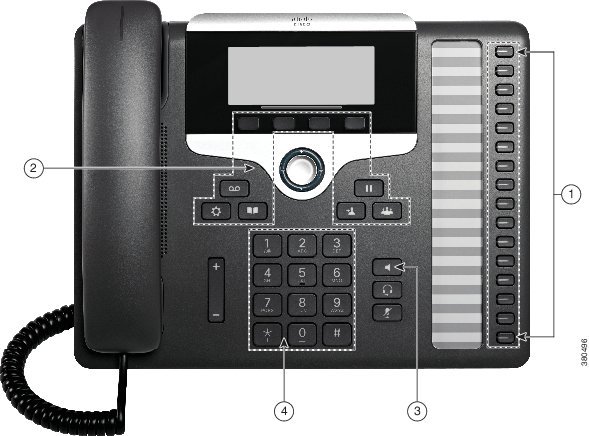
|
Item |
Accessibility Feature |
Description |
|---|---|---|
|
1 |
Lighted buttons on the Cisco IP Phone 7821, 7841, and 7861 The Cisco IP Phone 7811 does not have programmable line buttons. |
Allow you to access the following features:
Indicate your phone's status:
|
|
2 |
Large buttons to access Applications, Messages, Contacts, Hold, Transfer, and Conference |
Allow you to easily access your phone applications, voice messages, corporate and personal directories, and calling features. |
|
3 |
Built-in speakerphone |
Indicates whether the speakerphone is on or off. When the speakerphone is on, the button is lit. |
|
4 |
Tactile-discernible buttons and functions, including a nib on Key 5 |
Allow you to easily locate your phone's keys. For example, Key 5 has a nib, which you can use to locate other key positions. |
The Cisco IP Phone 7800 Series phones can be mounted on a wall using one of the following wall mount kits:
-
Wallmount Kit for Cisco IP Phone 7811—used to mount a single Cisco IP Phone 7811 on the wall.
-
Wallmount Kit for Cisco IP Phone 7800 Series—used to mount a single Cisco IP Phone 7821 or 7841 on the wall.
Wallmount Kit for Cisco IP Phone 7861—used to mount a single Cisco IP Phone 7961 on the wall.
The wall mount kits meet the 307.2 Protrusion Limits section of the Americans with Disabilities Act (ADA) ADAAG requirement for mounting a phone on the wall.
The following figure shows a side view of the phone with the wall mount kit installed.

Your conference phone comes with standard accessibility features that require little or no setup.
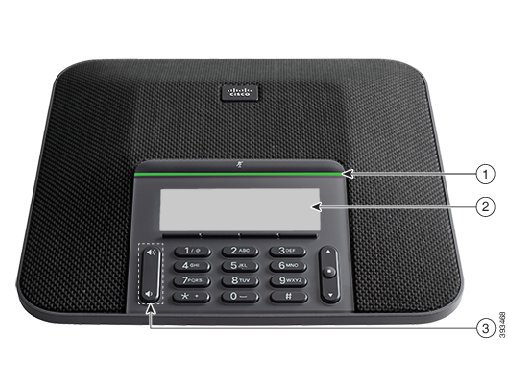
|
Item |
Accessibility Feature |
Description |
|---|---|---|
|
1 |
LED bar |
The phone screen displays the current state and the LED bar displays:
|
|
2 |
Visual notification of the phone state and message-waiting indicator |
The phone screen displays the current state. When you have a message, a message is displayed on the phone screen. Your phone also provides an audible message-waiting indicator. |
|
3 |
Adjustable ringtone, pitch, and volume |
Your administrator can also change your settings. |
Your phone comes with standard accessibility features that require little or no setup.

The following table describes the vision-impaired and blind accessibility features on the Cisco IP Conference Phone 7832.
|
Item |
Accessibility Feature |
Description |
|---|---|---|
1 | Mute button
| Use the Mute button to toggle the microphone on or off. When the microphone is muted, the LED bar lights red. When you turn on Mute, your phone beeps once; when you turn off Mute, your phone beeps twice. |
|
2 |
High-contrast visual and audible alert of an incoming call with the LED bar
|
Alerts you to an incoming call. The LED flashes during incoming calls. Colors indicate your phone's status:
|
|
3 |
Back-lit grayscale LCD screen with adjustable contrast on the Cisco IP Phone |
Allows you to adjust your phone screen contrast. |
|
4 |
Softkeys
|
Provide access to special functions. The LCD displays the functions. |
|
5 |
Navigation cluster (includes the Navigation bar and the Select button)
|
Use the Navigation bar to move up and down in the phone LCD. The Select button is in the center of the Navigation bar. |
|
6 |
Standard 12-key layout |
Allows you to use existing or familiar key positions. Key 5 has a nib. |
|
7 | Volume key
| Allows you to increase or decrease the ring volume or the sound. Press up on the rocker key to increase the volume. Press down on the rocker key to decrease the volume. When you adjust the volume, the LED bar lights white to show the volume increase or decrease. |
Your conference phone comes with standard accessibility features that require little or no setup.
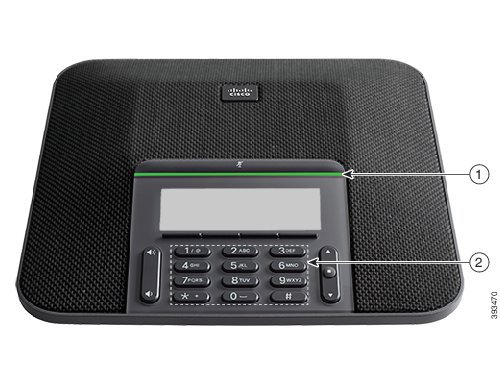
The following table describes the mobility-impaired accessibility features on the Cisco IP Conference Phone 7832.
|
Item |
Accessibility Feature |
Description |
|---|---|---|
|
1 |
LED bar |
Indicates your phone's status:
|
|
2 |
Tactile-discernible buttons and functions, including a nib on Key 5 |
Allow you to easily locate your phone's keys. For example, Key 5 has a nib, which you can use to locate other key positions. |
Your phone comes with standard accessibility features that require little or no setup.
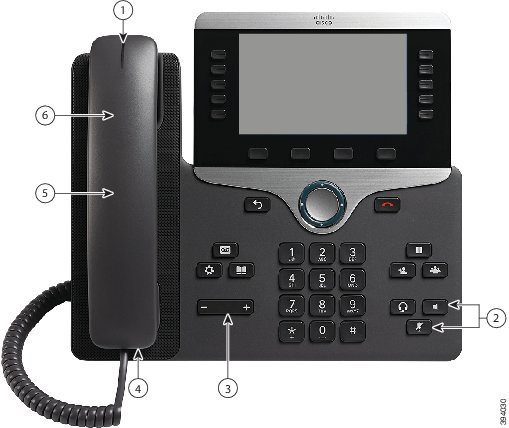
The following table describes the hearing-impaired accessibility features on the Cisco IP Phone 8800 Series Multiplatform Phones.
|
Item |
Accessibility Feature |
Description |
|---|---|---|
|
1 |
Visual message-waiting indicator (handset) |
This lighted strip is visible from all angles. Your phone also provides an audible message-waiting indicator. To change the light or the audible voice-message indicator, sign in to the phone support pages and access the message-indicator settings. Your administrator can also change your settings. |
|
2 |
Visual notification of phone state |
|
|
3 |
Adjustable ringtone, pitch, and volume |
Your administrator can also change your settings. |
|
4 |
Inline-amplifier support (handset) |
Cisco IP Phone handsets support third-party inline amplifiers. You attach an amplifier to the handset and cord and it sits between the handset and the IP phone. |
|
5 |
Hearing aid compatible (HAC) handset |
Supports these accessibility features:
|
|
6 |
Acoustic coupled TTY and TDD support (handset) |
Cisco IP Phones support these TTY and TDD features:
For information about setting up TTY, contact your administrator. |
Your Multiplatform phone comes with standard accessibility features that require little or no setup.

|
Item |
Accessibility Feature |
Description |
|---|---|---|
|
1 |
High-contrast visual and audible alert of an incoming call |
Alerts you to an incoming call. The handset light strip flashes during incoming calls and stays lit when a voicemail message is received. |
|
2 |
Programmable feature buttons and line buttons |
Feature and line buttons, located on either side of the screen, give you access to phone features and phone lines.
Colors indicate your phone's status:
|
|
3 |
Back-lit color LCD screen on the Cisco IP Phone
|
Allows you to adjust your phone screen's brightness. |
|
4 |
Softkeys
|
Provide access to special functions. The functions are displayed on the LCD. |
|
5 |
Navigation Cluster (includes the Navigation ring and the Select button)
|
Use the Navigation ring to move up, down, left, and right in the phone LCD. The Select button is in the center of the Navigation cluster. Use the Back button to return to the previous screen or menu. Use the Release (End Call) button to end a call or session. |
|
6 |
Messages button, Applications button, and Contacts button
|
Allow you to easily access your messages, applications, and contacts. |
|
7 |
Hold button, Transfer button, and Conference button
|
Allow you to use these functions on your phone. |
|
8 |
Volume key
|
Allows you to increase or decrease the ring volume or the sound through the handset, headset, or speakerphone. Press the right side of the rocker key to increase the volume; press the left side of the rocker key to decrease the volume. |
|
9 |
Standard 12-key layout |
Allows you to use existing or familiar key positions. Key 5 has a nib. |
|
10 |
Headset, Speakerphone, and Mute buttons
|
Provide audible notification of the phone state:
|
Adjustable Footstand
You can adjust the footstand to provide optimum phone display viewing and easy access to all buttons and keys.
Voice Feedback helps people vision problems to use their Cisco IP Phone. When enabled, a voice prompt helps you navigate your phone buttons, and to use and configure phone features. The voice also reads out incoming Caller IDs, displayed screens and settings, and button functions.
This feature is available on Cisco IP Phone 8800 Series and Cisco IP Phone 8800 Series Multiplatform Phones.
Here are a few important items to keep in mind as you use this feature.
-
Voice Feedback is enabled and disabled with the Select button that is located in the center of the Navigation cluster. When the phone is idle, quickly tap Select three times to turn this feature on or off. A voice prompt alerts you to the feature status.
-
Push a softkey once, and Voice Feedback reads out the feature that is associated with the key. Quickly push the softkey twice to execute the feature.
-
Hard keys, such as the Contacts, Applications, and Messages buttons, are treated differently. Push a hard key once, and a voice reads out the screen name followed by the application or setting that is displayed on the phone.
Volume is adjusted with the Volume button. To adjust your handset volume, lift the receiver from the cradle, and press Volume. If you use a headset, select the Headset button, and then Volume. If you use the speakerphone, select Speakerphone and Volume.
You may not hear Voice Feedback if you select the Headset button, but don't have a connected headset. Select Speakerphone and you hear Voice Feedback again.
When on a call, only you hear Voice Feedback so your privacy is assured. Voice Feedback is only available for English language users. If this feature is not available to you, then it is disabled on your phone.
To have a better visual experience, you can adjust the size of the fonts that are displayed on the phone screen. Note that the customization of the font size does not change few of the texts, such as the texts in a prompt window.
To adjust the font size, press Settings on your phone. Select . Press the Select button to check the font size options. Press Set to choose and save a font size. The font size change is applied immediately.
Your phone comes with standard accessibility features that require little or no setup.
To check which phone model you have, press Applications ![]() and select . The Product name field shows your phone model.
and select . The Product name field shows your phone model.
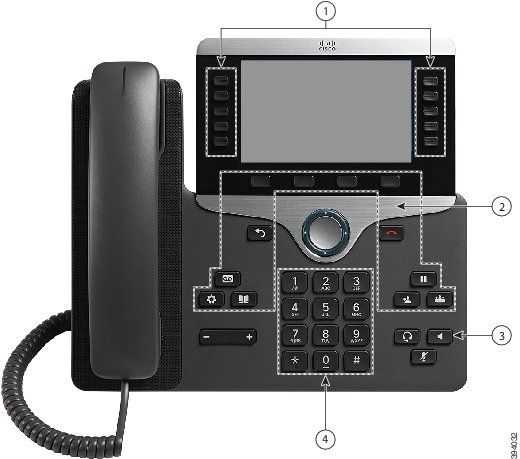
The following table describes the mobility-impaired accessibility features on the Cisco IP Phone 8800 Series.
|
Item |
Accessibility Feature |
Description |
|---|---|---|
|
1 |
Lighted buttons |
Allow you to access the following features:
Indicate your phone's status:
|
|
2 |
Large buttons to access Applications, Messages, Contacts, Hold, Transfer, and Conference |
Allow you to easily access your phone applications, voice messages, corporate and personal directories, and calling features. |
|
3 |
Built-in speakerphone |
Indicates whether the speakerphone is on or off. When the speakerphone is on, the button is lit. |
|
4 |
Tactile-discernible buttons and functions, including a nib on Key 5 |
Allow you to easily locate your phone's keys. For example, Key 5 has a nib, which you can use to locate other key positions. |
The Cisco IP Phone 8800 Series phones can be mounted on a wall using one of the following wall mount kits:
-
Wallmount Kit for Cisco IP Phone 8800 Series—used to mount a single phone on the wall.
-
Wallmount Kit for Cisco IP Phone 8800 Series with single KEM—used to mount a single phone with one attached key expansion module on a wall.
-
Wallmount Kit for Cisco IP Phone 8800 Video Series—used to mount a single video phone on the wall.
The Wallmount Kit for Cisco IP Phone 8800 Series and Wallmount Kit for Cisco IP Phone 8800 Series with single KEM meet the 307.2 Protrusion Limits section of the Americans with Disabilities Act (ADA) ADAAG requirement for mounting a phone on the wall.
The Wallmount Kit for Cisco IP Phone 8800 Video Series is slightly larger and does not meet the 307.2 Protrusion Limits section of the Americans with Disabilities Act (ADA) ADAAG requirement for mounting a phone on the wall.
The following figure shows a side view of the phone with the wall mount kit installed.

Your conference phone comes with standard accessibility features that require little or no setup.
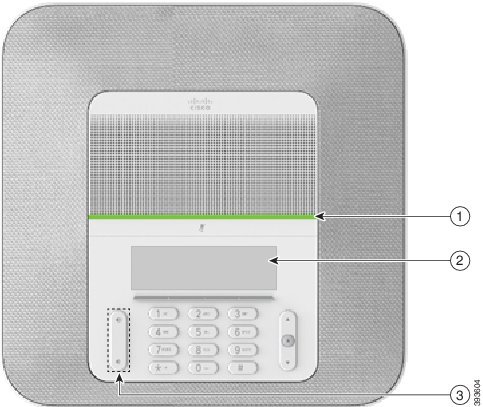
The following table describes the hearing-impaired accessibility features on the Cisco IP Conference Phone 8832.
|
Item |
Accessibility Feature |
Description |
|---|---|---|
|
1 |
LED bar |
The phone screen displays the current state and the LED bar displays:
|
|
2 |
Visual notification of phone state and message-waiting indicator |
The phone screen displays the current state. When you have a message, a message is displayed on the phone screen. Your phone also provides an audible message-waiting indicator. |
|
3 |
Adjustable ringtone, pitch, and volume |
Your administrator can also change your settings. |
Your phone comes with standard accessibility features that require little or no setup.
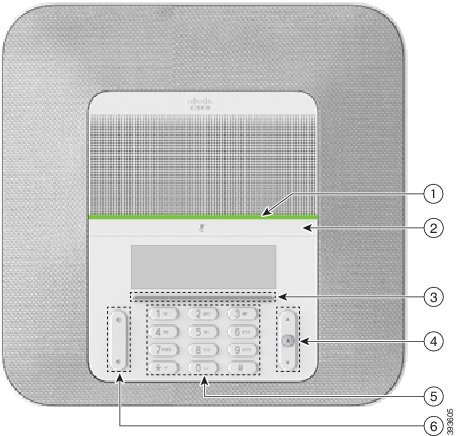
The following table describes the vision-impaired and blind accessibility features on the Cisco IP Conference Phone 8832.
|
Item |
Accessibility Feature |
Description |
|---|---|---|
|
1 |
High-contrast visual and audible alert of incoming call with the LED bar
|
Use the Mute button to toggle the microphone on or off. When the microphone is muted, the LED bar lights red. When you turn on Mute, your phone beeps once; when you turn off Mute, your phone beeps twice. |
|
2 |
Mute button
|
Alerts you to an incoming call. The LED flashes during incoming calls. Colors indicate your phone's status:
|
|
3 |
Softkeys
|
Provide access to special functions. The LCD displays the functions. |
|
4 |
Navigation cluster (includes the Navigation bar and the Select button)
|
Use the Navigation bar to move up and down in the phone LCD. The Select button is in the center of the Navigation bar. |
|
5 |
Standard 12-key layout |
Allows you to use existing or familiar key positions. Key 5 has a nib. |
|
6 |
Volume key
|
Allows you to increase or decrease the ring volume or the sound. Press up on the rocker key to increase the volume. Press down on the rocker key to decrease the volume. When you adjust the volume, the LED bar lights white to show the volume increase or decrease. |
Voice feedback helps people who have trouble seeing use their Cisco IP phone. When enabled, a voice prompt helps you navigate your phone buttons, and to use and configure phone features. The voice feedback also reads incoming caller IDs, displayed screens and settings, and button functions. When on a call, only you hear voice feedback so your privacy is assured.
One of the methods to enable and disable voice feedback is to use the Select button that is located in the center of the Navigation bar. When the phone is idle, quickly press Select three times to turn this feature on or off. A voice prompt alerts you to the feature status.
After voice feedback is enabled, press a softkey once, and voice feedback reads the feature that is associated with the key. Quickly press the softkey twice to execute the feature.
Voice feedback is only available for English language users. If this feature is not available to you, then it is disabled on your phone.
To have a better visual experience, you can adjust the size of the fonts that are displayed on the phone screen. Note that the customization of the font size does not change few of the texts, such as the texts on the phone screen header row (the current date and time), the texts on the bottom row (the softkey labels), and the texts in a prompt window.
To adjust the font size, press Settings on your phone. Select . Press the Select button to check the font size options. Press Set to choose and save a font size. The font size change is applied immediately.
Your conference phone comes with standard accessibility features that require little or no setup.
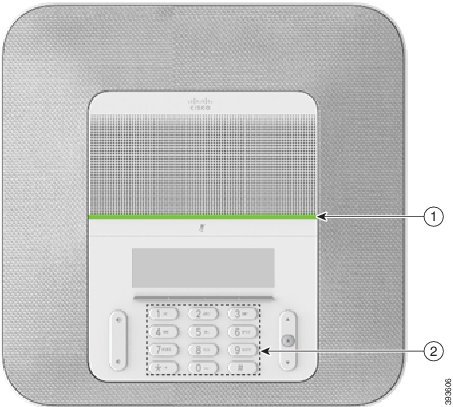
The following table describes the mobility-impaired accessibility features on the Cisco IP Conference Phone 8832.
|
Item |
Accessibility Feature |
Description |
|---|---|---|
|
1 |
LED bar |
Indicates your phone's status:
|
|
2 |
Tactile-discernible buttons and functions, including a nib on Key 5 |
Allow you to easily locate your phone's keys. For example, Key 5 has a nib, which you can use to locate other key positions. |


